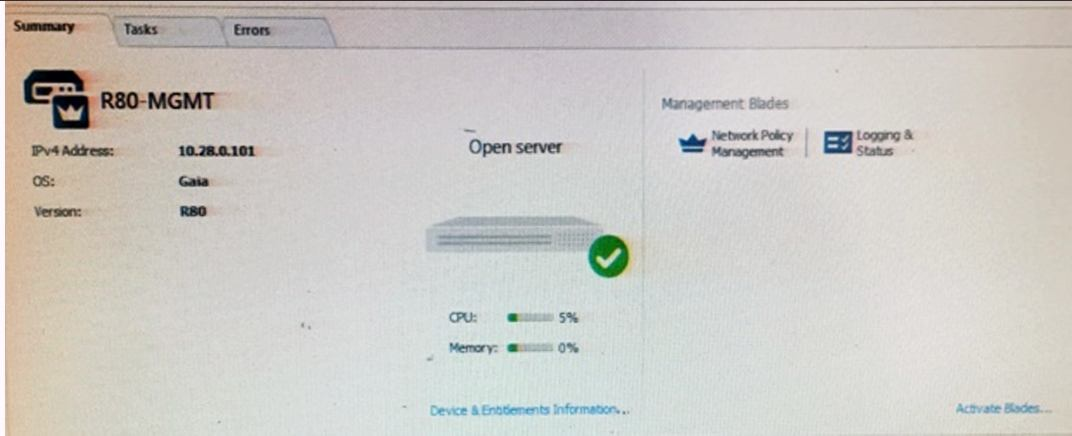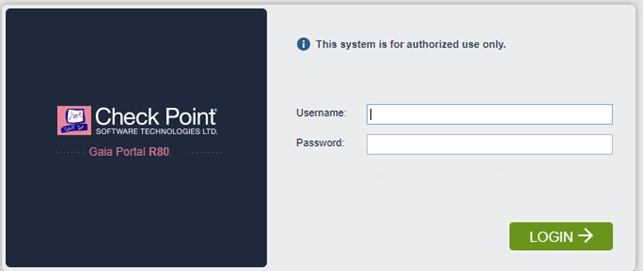Download Check Point Certified Security Administrator.156-215.80.ActualTests.2019-02-05.251q.vcex
| Vendor: | Checkpoint |
| Exam Code: | 156-215.80 |
| Exam Name: | Check Point Certified Security Administrator |
| Date: | Feb 05, 2019 |
| File Size: | 8 MB |
How to open VCEX files?
Files with VCEX extension can be opened by ProfExam Simulator.
Discount: 20%
Demo Questions
Question 1
Packages and licenses are loaded from all of these sources EXCEPT
- Download Center Web site
- UserUpdate
- User Center
- Check Point DVD
Correct answer: B
Explanation:
Packages and licenses are loaded into these repositories from several sources: the Download Center web site (packages) the Check Point DVD (packages) the User Center (licenses) by importing a file (packages and licenses) by running the cplic command line Reference: https://sc1.checkpoint.com/documents/R76/CP_R76_Installation_and_Upgrade_Guide-webAdmin/13128.htm Packages and licenses are loaded into these repositories from several sources:
- the Download Center web site (packages)
- the Check Point DVD (packages)
- the User Center (licenses)
- by importing a file (packages and licenses)
- by running the cplic command line
Reference: https://sc1.checkpoint.com/documents/R76/CP_R76_Installation_and_Upgrade_Guide-webAdmin/13128.htm
Question 2
Which of the following technologies extracts detailed information from packets and stores that information in state tables?
- INSPECT Engine
- Stateful Inspection
- Packet Filtering
- Application Layer Firewall
Correct answer: B
Explanation:
Reference: https://www.checkpoint.com/smb/help/utm1/8.2/7080.htm Reference: https://www.checkpoint.com/smb/help/utm1/8.2/7080.htm
Question 3
On the following graphic, you will find layers of policies.

What is a precedence of traffic inspection for the defined polices?
- A packet arrives at the gateway, it is checked against the rules in the networks policy layer and then if implicit Drop Rule drops the packet, it comes next to IPS layer and then after accepting the packet it passes to Threat Prevention layer.
- A packet arrives at the gateway, it is checked against the rules in the networks policy layer and then if there is any rule which accepts the packet, it comes next to IPS layer and then after accepting the packet it passes to Threat Prevention layer
- A packet arrives at the gateway, it is checked against the rules in the networks policy layer and then if there is any rule which accepts the packet, it comes next to Threat Prevention layer and then after accepting the packet it passes to IPS layer.
- A packet arrives at the gateway, it is checked against the rules in IPS policy layer and then it comes next to the Network policy layer and then after accepting the packet it passes to Threat Prevention layer.
Correct answer: B
Explanation:
To simplify Policy management, R80 organizes the policy into Policy Layers. A layer is a set of rules, or a Rule Base. For example, when you upgrade to R80 from earlier versions:Gateways that have the Firewall and the Application Control Software Blades enabled will have their Access Control Policy split into two ordered layers: Network and Applications.When the gateway matches a rule in a layer, it starts to evaluate the rules in the next layer. Gateways that have the IPS and Threat Emulation Software Blades enabled will have their Threat Prevention policies split into two parallel layers: IPS and Threat Prevention.All layers are evaluated in parallel Reference: https://sc1.checkpoint.com/documents/R80/CP_R80_SecMGMT/html_frameset.htm?topic=documents/R80/CP_R80_SecMGMT/126197 To simplify Policy management, R80 organizes the policy into Policy Layers. A layer is a set of rules, or a Rule Base.
For example, when you upgrade to R80 from earlier versions:
- Gateways that have the Firewall and the Application Control Software Blades enabled will have their Access Control Policy split into two ordered layers: Network and Applications.When the gateway matches a rule in a layer, it starts to evaluate the rules in the next layer.
- Gateways that have the IPS and Threat Emulation Software Blades enabled will have their Threat Prevention policies split into two parallel layers: IPS and Threat Prevention.
All layers are evaluated in parallel
Reference: https://sc1.checkpoint.com/documents/R80/CP_R80_SecMGMT/html_frameset.htm?topic=documents/R80/CP_R80_SecMGMT/126197
Question 4
Tina is a new administrator who is currently reviewing the new Check Point R80 Management console interface. In the Gateways view, she is reviewing the Summary screen as in the screenshot below. What as an 'Open Server'?

- Check Point software deployed on a non-Check Point appliance.
- The Open Server Consortium approved Server Hardware used for the purpose of Security and Availability.
- A check Point Management Server deployed using the Open Systems Interconnection (OSI) Server and Security deployment model.
- A check Point Management Server software using the Open SSL.
Correct answer: A
Explanation:
Reference: https://sc1.checkpoint.com/documents/R76/CP_R76_Installation_and_Upgrade_Guide-webAdmin/index.html 
Reference: https://sc1.checkpoint.com/documents/R76/CP_R76_Installation_and_Upgrade_Guide-webAdmin/index.html
Question 5
Choose what BEST describes the Policy Layer Traffic Inspection.
- If a packet does not match any of the inline layers, the matching continues to the next Layer.
- If a packet matches an inline layer, it will continue matching the next layer.
- If a packet does not match any of the inline layers, the packet will be matched against the Implicit Clean-up Rule.
- If a packet does not match a Network Policy Layer, the matching continues to its inline layer.
Correct answer: B
Explanation:
Reference: https://community.checkpoint.com/thread/1092 Reference: https://community.checkpoint.com/thread/1092
Question 6
What are the three conflict resolution rules in the Threat Prevention Policy Layers?
- Conflict on action, conflict on exception, and conflict on settings
- Conflict on scope, conflict on settings, and conflict on exception
- Conflict on settings, conflict on address, and conflict on exception
- Conflict on action, conflict on destination, and conflict on settings
Correct answer: C
Question 7
What does the “unknown” SIC status shown on SmartConsole mean?
- The SMS can contact the Security Gateway but cannot establish Secure Internal Communication.
- SIC activation key requires a reset.
- The SIC activation key is not known by any administrator.
- There is no connection between the Security Gateway and SMS.
Correct answer: D
Explanation:
The most typical status is Communicating. Any other status indicates that the SIC communication is problematic. For example, if the SIC status is Unknown then there is no connection between the Gateway and the Security Management server. If the SIC status is Not Communicating, the Security Management server is able to contact the gateway, but SIC communication cannot be established. Reference: https://sc1.checkpoint.com/documents/R76/CP_R76_SecMan_WebAdmin/html_frameset.htm?topic=documents/R76/CP_R76_SecMan_WebAdmin/118037 The most typical status is Communicating. Any other status indicates that the SIC communication is problematic. For example, if the SIC status is Unknown then there is no connection between the Gateway and the Security Management server. If the SIC status is Not Communicating, the Security Management server is able to contact the gateway, but SIC communication cannot be established.
Reference: https://sc1.checkpoint.com/documents/R76/CP_R76_SecMan_WebAdmin/html_frameset.htm?topic=documents/R76/CP_R76_SecMan_WebAdmin/118037
Question 8
Kofi, the administrator of the ABC Corp network wishes to change the default Gaia WebUI Portal port number currently set on the default HTTPS port.
Which CLISH commands are required to be able to change this TCP port?

- set web ssl-port <new port number>
- set Gaia-portal <new port number>
- set Gaia-portal https-port <new port number>
- set web https-port <new port number>
Correct answer: A
Explanation:
1. Explanation: In Clish A. Connect to command line on Security Gateway / each Cluster member. B. Log in to Clish. C. Set the desired port (e.g., port 4434):HostName> set web ssl-port <Port_Number> D. Save the changes:HostName> save config E. Verify that the configuration was saved:[Expert@HostName]# grep 'httpd:ssl_port' /config/db/initialReference: https://supportcenter.checkpoint.com/supportcenter/portal?eventSubmit_doGoviewsolutiondetails=&solutionid=sk83482 1. Explanation:
In Clish
A. Connect to command line on Security Gateway / each Cluster member.
B. Log in to Clish.
C. Set the desired port (e.g., port 4434):
HostName> set web ssl-port <Port_Number>
D. Save the changes:
HostName> save config
E. Verify that the configuration was saved:
[Expert@HostName]# grep 'httpd:ssl_port' /config/db/initial
Reference: https://supportcenter.checkpoint.com/supportcenter/portal?eventSubmit_doGoviewsolutiondetails=&solutionid=sk83482
Question 9
Fill in the blank: Browser-based Authentication sends users to a web page to acquire identities using ________ .
- User Directory
- Captive Portal and Transparent Kerberos Authentication
- Captive Portal
- UserCheck
Correct answer: B
Explanation:
To enable Identity Awareness: Log in to SmartDashboard. From the Network Objects tree, expand the Check Point branch. Double-click the Security Gateway on which to enable Identity Awareness. In the Software Blades section, select Identity Awareness on the Network Security tab. The Identity Awareness Configuration wizard opens. Select one or more options. These options set the methods for acquiring identities of managed and unmanaged assets. AD Query - Lets the Security Gateway seamlessly identify Active Directory users and computers. Browser-Based Authentication - Sends users to a Web page to acquire identities from unidentified users. If Transparent Kerberos Authentication is configured, AD users may be identified transparently. Reference: https://sc1.checkpoint.com/documents/R76/CP_R76_IdentityAwareness_AdminGuide/62050.htm To enable Identity Awareness:
- Log in to SmartDashboard.
- From the Network Objects tree, expand the Check Point branch.
- Double-click the Security Gateway on which to enable Identity Awareness.
- In the Software Blades section, select Identity Awareness on the Network Security tab.The Identity Awareness Configuration wizard opens.
- Select one or more options. These options set the methods for acquiring identities of managed and unmanaged assets.
- AD Query - Lets the Security Gateway seamlessly identify Active Directory users and computers.
- Browser-Based Authentication - Sends users to a Web page to acquire identities from unidentified users. If Transparent Kerberos Authentication is configured, AD users may be identified transparently.
Reference: https://sc1.checkpoint.com/documents/R76/CP_R76_IdentityAwareness_AdminGuide/62050.htm
Question 10
Which default user has full read/write access?
- Monitor
- Altuser
- Administrator
- Superuser
Correct answer: C
HOW TO OPEN VCE FILES
Use VCE Exam Simulator to open VCE files

HOW TO OPEN VCEX AND EXAM FILES
Use ProfExam Simulator to open VCEX and EXAM files


ProfExam at a 20% markdown
You have the opportunity to purchase ProfExam at a 20% reduced price
Get Now!



